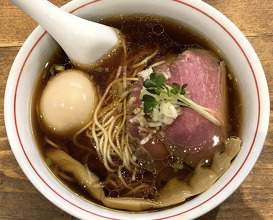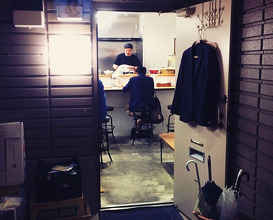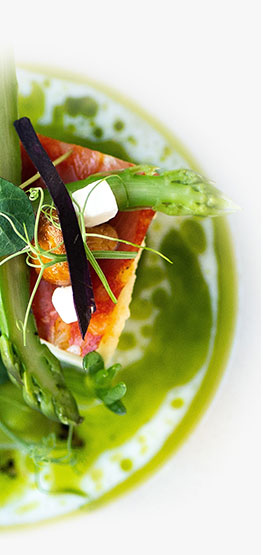Recommended bowl: Superb tori-soba
The vibe at Rage is new school and easygoing. In both style and substance, the shop represents the next generation of the Tokyo scene. Located down a shotengai in the quirky neighborhood of Nishi-Ogikubo, the shop's interior is simple and spacious. Street art made by master Hirota-san's friends cover the walls; skateboards and single-speed bikes are often parked at the entryway.
On standard days of service, Rage offers three bowls: shamo soba, (a chicken-based shoyu ramen, also known as tori-soba), niboshi ramen and maze-soba. All three are excellent, but the shamo soba is probably Hirota-san's most popular bowl. A tokusei extra-topping option is available, and highly recommended.
Rage's shamo soba soup is made with two types of shoyu — ki-joyuu and kaeshi — and four types of shamo chicken. Shamo is a flavor-rich variety of fighting cock that came to Japan by way of Thailand (Shamo was a corruption of the word "Siam" during the early Edo period). Hirota-san uses shamo chickens sourced from a few different farms around the country, including "Tokyo shamo" (farmed near the capital), "Aomori shamo-rokku" (Aomori is a city in Japan's northern Tohoku region), "Tochigi ougon shamo" (Tochigi is an area just north of Tokyo; ougon = golden), "Tosa shamo" (Tosa is the old name for Kochi Prefecture).
If you order the tokusei bowl with extra toppings, you will get tender chicken chashu and two types of pork chashu. The less fatty of the two is made from Japanese kinka ham, a variety of cured Chinese ham that is traditionally used in Chinese soups. Kinka pigs are raised on a diet without grain, which results in a leaner meat. After the hind legs of the pigs are salted and hung in a breezy spot to dry, a mold forms on the exterior as the ham matures underneath. The process is similar to the way bonito is cured in Japan, so it's sometimes referred to as "bonito ham" here. The bowls are finished with noodles from Mikawaya Seimen, a top noodle purveyor.
Rage's niboshi ramen is just as legit as the shamo soba. It's lightly bitter with a nice umami undertow. Hirota-san puts four varieties of niboshi into the soup — baby anchovy, shirose (a kind of sardine), iwashi (standard sardine), and mackerel. Also in the mix: konbu, yakiboshi (dried, slow-grilled fish) and a little house-made niboshi oil made from shirose soaked in shirashimeyu (refined canola oil).
If you're in a no-soup mood, go for the maze-soba. It comes with a smoked egg yolk, which infuses the whole dish with rich, slow-smoked goodness. A slice of lemon freshens it up. It's like a soup-less ramen BBQ in a bowl.
Every Monday, Hirota-san runs a "Monday Ramen" special, suspending the shop's usual menu to flex his muscles and do some experimenting. Sometimes he'll prepare an extra pungent niboshi, other days its some experimental tori soba. It's a nice way for the master to keep things interesting for both himself and his local fans. High quality assured.




